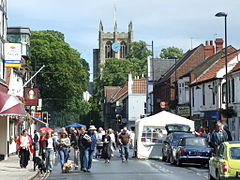Cottingham, East Riding of Yorkshire
| Cottingham | |
|---|---|
 Hallgate during the annual Cottingham Day |
|
| Cottingham shown within the East Riding of Yorkshire | |
| Population | 17,164 (2011 census) |
| OS grid reference | TA046329 |
| • London | 155 mi (249 km) S |
| Civil parish |
|
| Unitary authority | |
| Ceremonial county | |
| Region | |
| Country | England |
| Sovereign state | United Kingdom |
| Post town | COTTINGHAM |
| Postcode district | HU16 |
| Dialling code | 01482 |
| Police | Humberside |
| Fire | Humberside |
| Ambulance | Yorkshire |
| EU Parliament | Yorkshire and the Humber |
| UK Parliament | |
Cottingham is a large village and civil parish in the East Riding of Yorkshire, England with average affluence. It lies just to the north-west of the city of Kingston upon Hull, and 4.5 miles from the city centre. With a parish population of over 17,000 in 2011, Cottingham is one of the villages claiming to be the largest village in England.
According to one etymology, "Cottingham" is thought to derive from both British and Saxon root words: "Cot" from Ket, relating to the deity Ceridwen; ing a water meadow; and ham meaning home; the name corresponding to "habitation in the water meadows of Ket". The name has also been suggested to derive from a man's name "Cotta" plus -inga- (OE belonging to/named after) and ham; corresponding to "habitation of cotta's people". Archaic spellings include Cotingeham (Domesday, 1086), and Cotingham (Charter, 1156; John Leland, 1770).
The pre-conquest owner of Cottingham was Gamel, the son of Osbert, during the reign of Edward the Confessor in the 11th century. After the Norman conquest the land was in the possession of Hugh FitzBaldrick. At this time, the Domesday Book (1086) shows the Cottingham manor included a mill, five fisheries, woodland and farm land. In 1089 the manor was given to Robert Front de Boeuf, founder of the de Stuteville family line.
In 1201 a licence to fortify was obtained by William de Stuteville; the beginnings of Baynard Castle. The ownership of the manor passed to the de Wake family through de Stuteville's granddaughter Joan, who married Hugh de Wake. In 1327 further licence to crenelate the castle was given to Thomas Wake. According to legend, the manor house at the castle was destroyed by its owner, in 1541, on account of a proposed visit by Henry VIII; the owner, fearing the monarch's intentions towards his wife, sought to prevent the King's visit by ordering the arson of his own home.
...
Wikipedia

